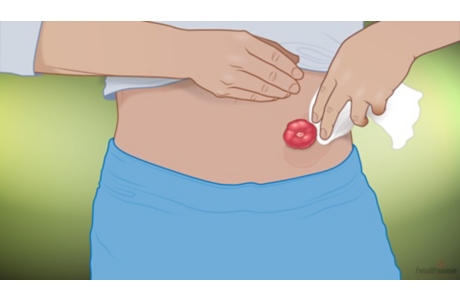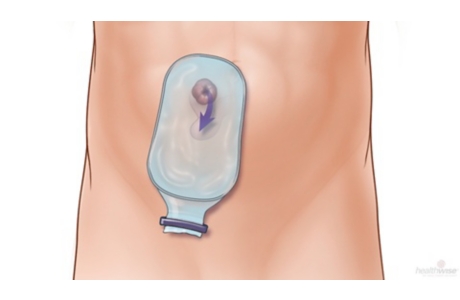Top of the pageActionset
Bowel Disease: Caring for Your Ostomy
Overview
Caring for your ostomy is an important part of maintaining your quality of life. You will need to:
- Empty your pouch as needed. Some pouches can be drained and reused. Other pouches are closed and must be thrown away after each use.
- Replace your pouching system as needed (usually every 3 to 7 days). This may include measuring your stoma (the exposed section of intestine) and cutting a barrier to fit around it.
- Care for your skin and stoma, and watch for skin irritation.
- Know what to watch for. Your doctor or nurse can help you with this.
Wound, ostomy, and continence nurses (WOCNs) are available in some medical centers to help you learn how to care for your ostomy.
Irrigating your colostomy
If you have a colostomy, you may be able to irrigate it. A colostomy is an ostomy of the colon. Irrigation is a procedure in which you stimulate and flush the intestines at a regular time. It is typically done at the same time every day or every other day.
Irrigation helps you control when you get rid of solid wastes. If you irrigate, you may need only a cover or pad over your stoma and may not need an ostomy pouch.
Irrigation requires your doctor's approval and guidance. Only a colostomy can be irrigated. You cannot irrigate an ileostomy.
Caring for a child's ostomy
If you are caring for an infant or child with an ostomy, the same information and procedures generally apply. But a child's ostomy pouch will be smaller and will most likely need to be replaced more often. Different adhesives may be used to attach the pouch because a child's skin is more sensitive than an adult's skin. Your nurse will help you learn how to care for your child with an ostomy. Irrigation is not appropriate for children.
How do you care for your ostomy?
How to empty a drainable ostomy pouch
A drainable ostomy pouch opens at one end to allow you to empty it. The pouch is usually held shut with a clip system.
It is best to empty the pouch when it is one-third to one-half full. This prevents the pouch from getting too full and heavy and pulling off. Many people routinely empty the pouch each time they urinate.
Here are the basic steps.
- Place some toilet paper in the bowl.
This can help prevent splashing.
- Sit down on the toilet with the pouch between your legs.
- Unclip the pouch and allow its contents to fall into the toilet.
- Clean the end of the pouch with toilet paper.
- Reclip the pouch.
How to empty a closed ostomy pouch
A closed ostomy pouch is disposed of and replaced with a new one as needed. A closed pouch cannot be drained.
It is best to throw the pouch away when it is one-third to one-half full. This prevents the pouch from getting too full and heavy and pulling off.
Here are the basic steps.
- Unsnap the pouch from the barrier.
- Throw the pouch away.
Do not flush the pouch down the toilet. Putting it in a zippered plastic bag reduces odor.
- Attach a new pouch.
How to replace your ostomy pouch
How often you change your ostomy pouch depends on many things, including the type of stoma you have and what you prefer.
Some pouches are changed daily. Others are changed every 3 to 7 days. You may need to change your pouching system more often if there is a leak in the pouch or itching or burning under the barrier. The pouch itself is usually emptied or replaced after each bowel movement.
- Prepare the new pouch and barrier.
- Cut an opening in the new barrier.
Make the opening slightly larger than the stoma. Or you may have a precut barrier.
- If you have a two-piece system, snap the pouch to the barrier.
- Remove the paper backing from the barrier so that the adhesive is exposed.
- Cut an opening in the new barrier.
- Remove the old pouch and barrier.
- Peel away the barrier.
Gently lift the pouch while pressing down on the skin below the pouch. Be sure not to irritate the skin as you remove the barrier and pouch.
- If the pouch sticks and is difficult to remove, use an adhesive remover underneath the barrier.
- Dispose of the old pouch and barrier.
- Peel away the barrier.
- Clean your skin and stoma.
- Use a wet washcloth or wipe.
You may shower to clean the stoma. You may use soap, but if you do, rinse well.
- Allow your skin to dry.
- Check your skin and stoma for signs of irritation.
- Use a wet washcloth or wipe.
- Measure your stoma, if necessary.
After your surgery, the size of your stoma may change. Your doctor may want you to measure it. He or she will provide a measurement guide to help you do this.
- Put the new pouch on.
- Position the opening in the barrier around the stoma.
- Apply the sticky side to the skin.
- Press down until all edges are sealed.
You may need to use some skin barrier paste to obtain a better skin seal.
- If your pouch is open-ended, attach the clip.
How to treat skin irritation around your ostomy
If the skin under your ostomy pouch is red, irritated, or itchy, you'll need to treat your skin.
- Gently remove the pouch.
- Clean the skin under the pouch with water.
- Dry the skin.
- Sprinkle ostomy protective powder on the skin.
- Blot the protective powder off.
- Reattach or replace the pouching system.
If you continue to have skin irritation, talk with your wound, ostomy, and continence nurse (WOCN), another nurse, or a doctor.
How to irrigate a colostomy
To irrigate a colostomy, you'll need to have the right equipment and supplies ready, including:
- Lubricant.
- An irrigation set. This includes a container for water, tubing with a cone end (one end of the tubing attaches to the container and the cone end is inserted into the stoma), and a clamp.
- An irrigating sleeve and belt. The sleeve is a long, clear plastic bag, open at the top and bottom. It snaps onto the barrier.
- Toilet tissue.
- A toilet to dispose of waste.
A nurse or doctor will show you how to irrigate your colostomy. Here are the basic steps.
- Get ready to irrigate.
- Place 16 fl oz (473.2 mL) to 32 fl oz (946.4 mL) of lukewarm water in the container.
The exact amount depends on the person. Your nurse or doctor will help you determine the amount you need.
Use lukewarm water because cold water can cause cramping.
- Hang the container at about shoulder height.
This height will be 18 in. (45.7 cm) to 24 in. (61 cm) above your stoma.
You will need a hook or other device to do this.
- Find a comfortable position.
This may be a chair in front of the toilet or on the toilet.
- Place 16 fl oz (473.2 mL) to 32 fl oz (946.4 mL) of lukewarm water in the container.
- Prepare the equipment.
- Remove your colostomy pouch from the barrier.
- Snap the irrigation sleeve to the barrier.
- Attach the sleeve belt for security.
- Place the end of the sleeve in the toilet, bedpan, or other disposal unit.
- Unclamp the tubing to let some of the irrigation solution flow through the tubing and out the cone.
This removes air from the tubing.
- Reclamp the tube.
- Lubricate the irrigating cone.
- Gently insert the cone into the stoma through the upper opening in the sleeve.
Press the cone firmly but gently. Do not force the cone into the stoma or insert it more than 3 in. (7.6 cm) into the stoma.
- Irrigate.
- Unclamp the tube.
- Allow the irrigation solution to flow into the stoma slowly for 5 to 10 minutes.
If cramping occurs, stop the flow for a few seconds but leave the cone in place.
- When the desired amount of solution flows in, or when you feel full, clamp the tubing.
- Remove the irrigation cone from your stoma.
Waste will come out of the stoma and empty through the sleeve into the toilet or disposal unit.
- After the initial flow of waste slows down (10 to 15 minutes), you may clamp the sleeve shut at the bottom and move around.
Many people use this time for shaving and other grooming.
- When the waste return is completed, unsnap the sleeve and put on your usual pouch or covering.
It takes 30 to 45 minutes for all the waste to empty.
- Clean all supplies and store for reuse.
When should you call for help?
Call your doctor now or seek immediate medical care if:
- You are vomiting.
- You have new or worse belly pain.
- You have a fever.
- You cannot pass stools or gas.
Watch closely for changes in your health, and be sure to contact your doctor if:
- Your stoma turns pale or changes color.
- Your stoma swells or bleeds.
- You have little or no waste going into your pouch.
- You are worried or sad about how your body looks with a stoma or are anxious about how to care for the stoma.
Credits
Current as of: July 26, 2023
Author: Healthwise Staff
Clinical Review Board
All Healthwise education is reviewed by a team that includes physicians, nurses, advanced practitioners, registered dieticians, and other healthcare professionals.
Current as of: July 26, 2023
Author: Healthwise Staff
Clinical Review Board
All Healthwise education is reviewed by a team that includes physicians, nurses, advanced practitioners, registered dieticians, and other healthcare professionals.
This information does not replace the advice of a doctor. Healthwise, Incorporated, disclaims any warranty or liability for your use of this information. Your use of this information means that you agree to the Terms of Use. Learn how we develop our content.



